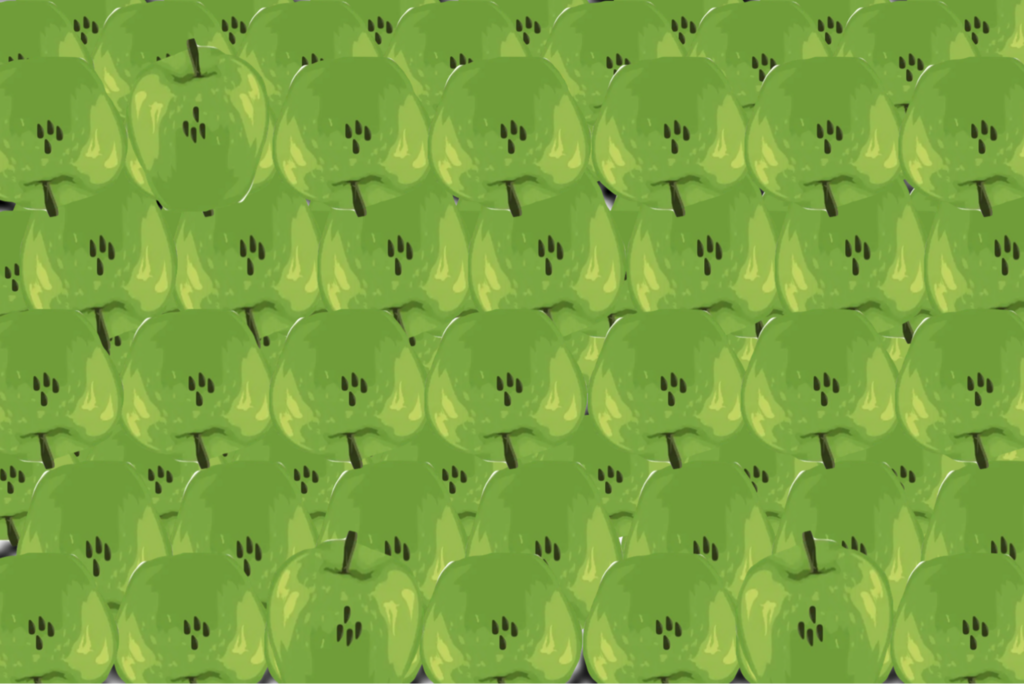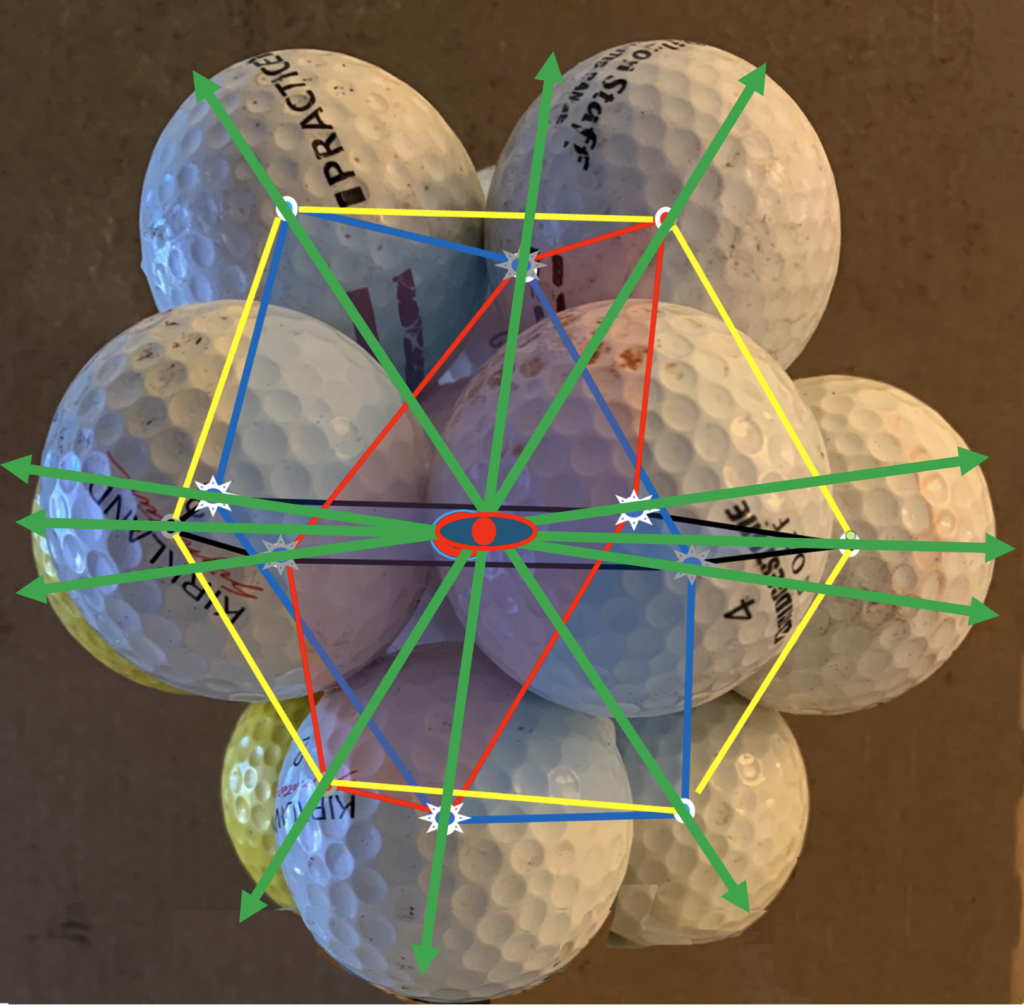In a dream, you envision yourself a very clever and fortunate worm in the core of a ‘Granny Smith’ apple.

You are endowed with X-ray vision so you can tell that your apple is just one of a multitude packed tightly in a virtually infinite box.

You cannot actually see what you presume to be the delicious flesh of the apples or whether there are other worms in those apples, your capabilities only allow you to see the seeds that reside in the central cores, although your thoughts are not so constrained which is why you know they are apples just like yours and you intellectualize the overlapping outlines of the spheres in a closest compaction.

But what can you actually see with your X-ray vision as you look out into your apple box universe? You see seeds, seeds everywhere, arranged in hexagon shapes as though you were looking into a kaleidoscope; that’s what you see.

As a very astute worm free of worry about insecticides, food shortages, or a place to live, you are allowed the luxury of noticing larger patterns, but your very astuteness ‘sees’ a pattern that isn’t what you could actually see. There is an angular dependence to what one could actually observe. At some angles the hexagons have seeds at their centers and at others they don’t. The hexagons without seeds at their centers have more seeds per point on their hexagons than the seed-centered hexagons do.

There is a regularity to this difference. In directions where you see hexagons without seeds at their centers, there are six surrounding directions with hexagons that do have seeds at their centers. Directions where seed-centered hexagons appear are surrounded by three seed-centered and three empty-centered hexagon regions. This might remind one of star-bellied sneeches and those without, but don’t let it.

Appearance is not reality even, or especially, in dreams; it is the projection angle that produces the difference in appearance.
A finger snaps. You are awaken. You are no longer a worm; they aren’t apples; what you envisioned as seeds are not seeds.
Maybe you are a bottom feeder as the dream drifts, a boojum who gobbles quarks in the nuclei of atoms. The apples are atoms now and the seeds are protons and neutrons in their nuclei and the tightly packed apples are crystalline structures of trillions of regularly stacked atoms. Maybe you are endowed with electron microscopy capabilities seeing only the nuclei of the packed apples or atoms or whatever they are. In directions where they are aligned, the image is more intense.
Or maybe as the dream continues to shift you are a top feeder gobbling galaxies one star at a time, a black hole at the center of a galaxy in the midst of galaxies at the center of a galaxy cluster. The seeds are galaxies and you are in a galaxy within a galaxy cluster and witness the vast number of galaxies in every direction.
Something snaps again. You are wide awake and and realize that you are none of those dreamt selves with their observational capabilities. You’re a human, on a planet in the solar system, aways out from the center of the Milky Way galaxy that can be observed as the brighter broad streak across the night sky if one gets out away from the city. But you can’t see much or very far with the naked eye; the resolution of your vision is extremely limited. The angular resolution of the naked eye (don’t you love that term?) is about 1 arcminute, approximately 0.017° or 0.0003 radians, which corresponds to about a foot and a half at one mile distance. The angular diameter of the closest star is about 0.0021 arcseconds or less than 0.0000001 radians; that is why stars appear as mere point sources of light. With good eyesight you could see maybe 6,000 of the closest of the approximately 100,000,000,000 stars in our galaxy. Our vision is also severely restricted to what is called ‘visible’ light on our behalf; from red to violet in a visible rainbow is a span of less than an order of magnitude in the spectrum of electromagnetic wavelengths that cover over 20 orders of magnitude from gamma rays, to hard X-rays, soft X-rays, ultraviolet, visible, ‘near’ and ‘far’ infrared, microwave, radio and television, and power wavelengths.

So we need ocular crutches to see out into our proverbial apple box universe. It becomes an intellectual endeavor of splicing together the signals detected by various instruments documented in technical papers accumulated over centuries rather than a mere matter of direct observation. We read textbooks and reports and look at images that are but analogies for our visual capabilities of what it would actually look like. So we’re still in the dream. But it’s a lucid dream of a blind man mapping the world around him with awareness derived from capabilities he does not possess.
We can accurately perceive what we cannot actually see because our brains can perform logical operations on the limited data we obtain and, by knowing how our instruments work, we can deduce the nature of what they detect. As we developed individually from infancy, we came to realize that ovals can sometimes be circular discs, etc. And over millennia the human species has deduced the general behavior of a host of ‘things’ of which our ‘world’ is comprised, although in some cases seldom, if ever, seen and has discovered additional even more subtle features of our world that have required instrumentation with greater resolution and more subtlety of thought to comprehend. Thus, ever so gradually the mysteries of our universe are being unraveled, but not without the occasional false impression along the way, among which my intuition places dark matter.
Electron beams that are shot through a one nanometer thick (about 100 atoms in depth) sheet of metal gives rise to an image from which to deduce the arrangement of atoms. The hexagonal patterns indicate tightly interconnected dodecahedron structures of atoms with four hexagonal planes. Through the central atom structure there are three non-planar lines of sight out of the plane of each hexagon for which atoms are touching all the way along in that direction. When an electron beam is aligned with these directions there is stronger response that shows up in the regions of the white hexagons superimposed on the earlier diagram. Perpendicular to each hexagon plane there are seven lines of sight passing through the centers of each atom, but there is a space between the atoms along these orthogonal directions that induce a response that is not so strong.


Quite frankly I cannot explain why there are regions of the image (with blue hexagons) for which the center is at least nearly as bright as the rest and the regions identified by the white hexagons that don’t. I’m working on it. But it is obvious that there are fewer, but still many, lines of sight for which the constituent entities are touching along those straight lines of sight.
Leave a Reply